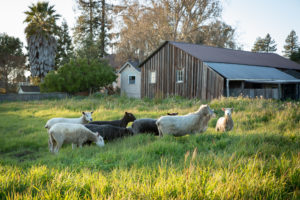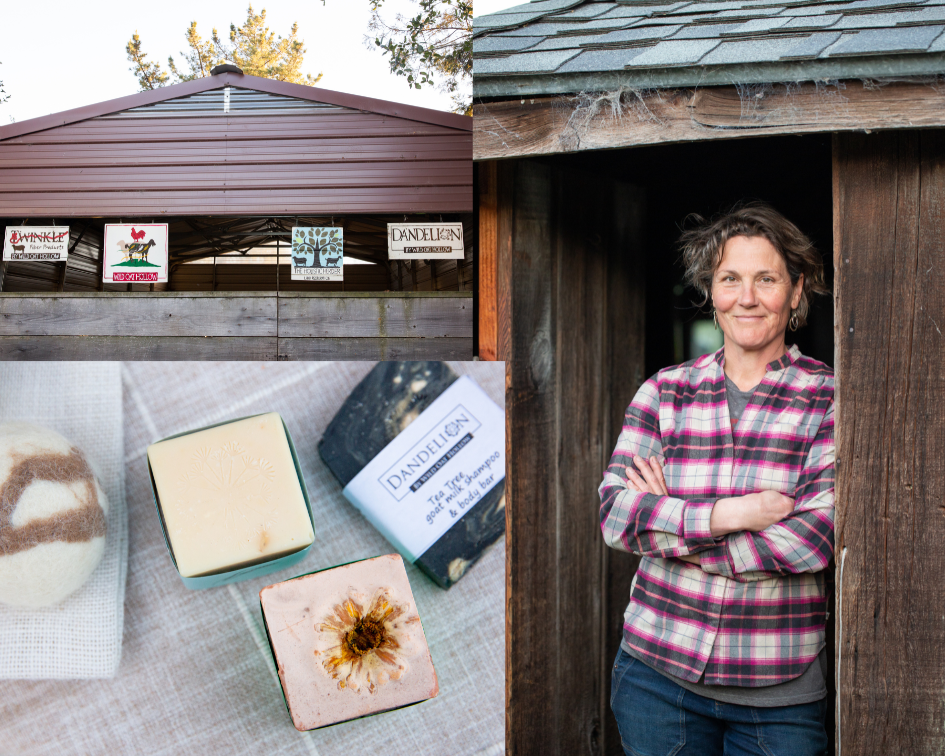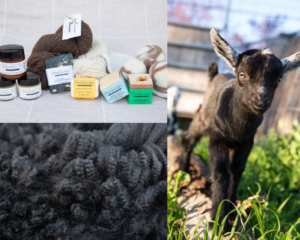Written by Marie Hoff; Photographed by Noelle Gaberman

Sarah arrived in balmy Penngrove, California to a plot of neglected land, overgrown with Spanish wild oats (Avena Barbata) in 2014. The adobe ground dried out and large cracks opened up the dry earth in the summer. She had two small children and no practical farming experience. A couple of scraggly oaks and willows adorned the edges of the property, with frequent traffic speeding by on the highway-like road. The house was small, awkward, and in disarray. She set down her roots and got to work.
Having grown up in a farm setting in Iowa, Sarah lived farm-adjacent for many years, spending summers on her aunt and uncle’s Midwest farm, working with horses as a farrier, engaged in environmentalism and outdoor activities since childhood. She never had the land to do her own farming projects until she moved to Penngrove. There, she found livestock as her way into a deeper understanding of environmentalism by growing plants and caring for animals. Now, with wool sheep, dairy goats, pigs, and chickens, her attunement to the health and life cycle of the plants and animals on her property has sharpened to a masterful touch. She seems to think like a plant, always looking for a new way to grow, a new niche to fill. Although the diversity of plants has now increased, in reverence of the initial wild oat, she named the farm Wild Oat Hollow.
Inspired and supported by Fibershed’s Climate Beneficial Wool program, Sarah began to work with Holistic Management expert Richard King and to develop a Carbon Farm Plan for Wild Oat Hollow. In addition to prescribed grazing (using duration and rest to graze for the benefit of plant life cycling), she planted hedgerows, restored riparian zones, mulched grassland, and installed a silvopasture – a grazing pasture sprinkled with trees including mulberry, chestnut, and persimmon. The land transformed.

Water moved differently, the air turned cooler and sweeter. Grass diversity in the fields increased, and with perennial grasses showing up the fields now stay greener, longer into the season. The adobe no longer dries to the point of cracking. Her children, Imogen and Gage, are growing into adolescence, and have become competent farm caregivers. Imogen loves the unicorn goat, Hazel, and when asked if she would want to move to a city when she grows up her 12 year old -going-on-40 year old eyes kind of widen as if to say ‘are you nuts?’ and she quickly responds, “Oh, no, once you live like this you never want to do anything else.” The original oaks and willows have grown thick and tall, along with the wide plethora of pollinator plants, medicinal herbs, native plants, and drought/fire resistant plants that buffer and block out the intensity of the speeding highway traffic, and line the riparian areas. There is always something blooming, and always in different colors.
Roughly 70% of the family’s food is grown on site, and that includes high quality and typically expensive proteins like milk, eggs, and meat. The kids have an active role in growing their own food, as well as soaps and other skincare essentials, and yarn. (The yarn bug does not seem to have bitten Imogen or Gage yet, but give it time). Their livelihood does not fit neatly onto a P & L style spreadsheet, it does more than just cover the mortgage. Their farm is their way of life, it is life, not a static number. Their livelihood is wrapped up in the living system that is their farmstead. The land supports their health, their wellness, their education, and their social and neighbor relationships — so critical to an area facing threats of drought and wildfire. The farmstead provides a good upbringing for the kids, while developing reciprocal relationships with her neighbors and the greater community. They, in return, care for the land.

Speaking of growing community, Sarah, like a plant outgrowing her pot, sought fertile grounds for her animals nearby, stretching to neighboring soil, as if a rhizome. She reached out to her neighbors after observing the common phenomenon of undergrazing/overgrazing around her. The phenomenon goes like so: because landholders are spread out, quiltlike, and typically tend to make decisions solely on their own square, those landholders end up overgrazing if they have livestock and undergrazing if they do not have livestock. The patchwork result is that some squares look bare and have a hard time retaining water while some squares look overgrown and dry out over summer to become a fire hazard. Rather than overgraze her square, Sarah broke down the arbitrary square layout in her neighborhood by spreading out the benefits of her grazing animals, to share amongst her neighbors who lack livestock of their own. In doing so she has begun to redefine what it means to live in a neighborhood based on grasslands.
It began as a simple exchange of grazing land for free mowing, on small properties close enough to walk animals to, a tiny transhumance. The endeavor has now grown into a 4 family collaborative, called Penngrove Grazing Project. Ming, Sarah’s neighbor across the street, with her children Celeste, age 10, and Bruno, age 6, says the collaborative is about more than free mowing. The social interaction and enjoyment of the sheep is priceless, her kids adore it, and they get exposure to working animals, and the process of new baby animals. Celeste is all attention to the baby goats’ antics. Bruno hangs out with Bruno, the baby goat named after him. As a relatively recent rural transplant from San Francisco’s Peninsula, there is nothing like this kind of experience for Ming and her family in the city. She also notes that the grazing provides better protection against the danger of fire, while making the soil healthier, with grazed areas noticeably growing back more quickly after the first rain than the non-grazed areas.

“We have very friendly sheep,” says Sarah, “they’re very good company when they go to other people’s properties.”
The neighbor collaboration worked so well that Sarah began to gain interest from people with grazing land further afield than walking distance. Rather than trailer her sheep, Sarah began another endeavor, Holistic Herder, which covers Sarah’s consulting and facilitation offerings for other residents in the Sonoma County area, those interested in starting their own grazing collaboratives. Each collaborative is slightly different, unique in its own makeup of participants and landscape. 10 separate collaboratives exist to date, each with their own structure, funding, name, and animals, but still with Sarah on hand as facilitator and animal husbandry consultant. Inspired by this community work, Sarah is now on Fibershed staff as the Intersectional Land Stewardship & Community Grazing Initiatives Coordinator. Watch for the forthcoming book about these community grazing projects, “Hooves & Hands: How We Work Together to Stay, to Heal, and to Coexist in Fire Ecosystems Facing Climate Change,” from Fibershed.

Back at home, Sarah stays busy with her fiber brand, Twinkle Fiber, and skincare label, Dandelion Skincare. Valley Oak Wool Mill spins the wool from her Romney, Merino, Wensleydale, Blue-Faced Leicester (BFL), and unique cross (Merino/Cormo/Lincoln/Wensleydale crosses from Red Creek Farm) sheep into beautiful breed-specific farm yarns for knitting and crochet. The yarns come in different colors, naturally-grown by the sheep. Dandelion Skincare offers salves, lotions, and soaps handmade by Sarah from milk from her goats, lard from her pigs, and herbs from her hedgerows.
If Sarah grows like a plant, so too does her community. Her community is a garden that grows and grows.
